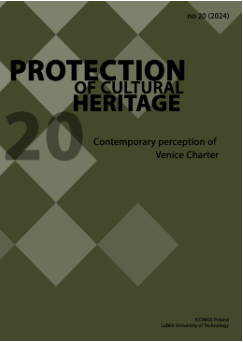MIEJSCA PAMIĘCI NA TLE UNESCO 1972 WORLD HERITAGE CONVENTION ORAZ KRYTERIUM VI WYTYCZNYCH OPERACYJNYCH JEJ STOSOWANIA
Abstrakt
Author argues that places of memory can be protected under 1972 UNESCO World Heritage Convention as definition of heritage (art. 1) encompasses „historical value” criterion in relation to all elements of this heritage, namely to monuments, groups of buildings and sites. Such thesis is strongly supported by practical application of criterion VI of Operational Guidelines by World Heritage Committee. Almost all monuments and sites inscribed on the World Heritage List under this criterion are to maintain memory of important events, beliefs, ideas etc. Intangible component was therefore a basis of these inscriptions although presence of material component as “a witness” was also important. It is however specially interesting to note that the Auschwitz Birkenau German Nazi Concentration Camp (1940-1945) was inscribed as the only one symbol of Holocaust what was underlined by the condition that no other such monuments would be inscribed in the future. It seems clear that by this fact the new principle of „symbolic representation” was adopted by Committee. The problem is that such principle has no legal basis, in particular it cannot be found in the 1972 Convention and for this reason decision establishing it is not binding for future inscriptions. Taking into account delicate and sometimes even political nature of inscription of some places of memory it seems reasonable that already existing practice of „serial inscriptions” can be adopted as a solution in cases of similar sites. It should make possible to leave apart the policy of „symbolic representation” as not only legally defective but leading also to situation where several places of memory of universal importance for whole humanity will stay without any legal protection.
Słowa kluczowe:
Konwencja UNESCO 1972, VI kryterium wytycznych operacyjnych, wpisBibliografia
Blake J., Developing a New Standard-setting Instrument for the Safeguarding of Intangible Heritage. Elements for Consideration. UNESCO, Paryż 2001.
Google Scholar
Brown G. B. , The care of ancient monuments. Cambridge 1905.
Google Scholar
Criteria for the assessment of Outstanding Universal Value.
Google Scholar
Edmondson R., The legal status of Memory of the World – time for a convention, [w:] W. Fałkowski (red.) Culture – Memory – Identities. Memory of the World Program and diversified perception of the past. Warszawa 2013.
Google Scholar
Francioni F. (red.) The 1972 World Heritage Convention. A Commentary. Oxford 2008.
Google Scholar
Francioni F., Lenzerini F., The future of the World Heritage Convention, [w:] F. Francioni (red.) The 1972 World Heritage Convention. A Commentary. Oxford 2008.
Google Scholar
Konferencja ICOMOS Miejsca pamięci – definiowanie, interpretacja – ochrona, 4/5.12.2017, Warszawa 2017.
Google Scholar
Konferencja ICOMOS Place of memory – protection, conservation, interpretation, 9.03.2017, Florencja 2017.
Google Scholar
Konferencja The place of memory and memory of place, 10.12.2016, Monticello House, Bloomsbury, Londyn 2016.
Google Scholar
Kowalski K.,O istocie dziedzictwa europejskiego – rozważania. MCK, Kraków 2013.
Google Scholar
Kowalski W., Kwalifikacja wartości zabytku w świetle prawa Stanów Zjednoczonych Ameryki Północnej. [w:] B. Szmygin (red.) Klasyfikacja i kategoryzacja w systemie ochrony zabytków. PKN ICOMOS Warszawa – Lublin 2016.
Google Scholar
Kowalski W., Place of memory as a legal concept. Current state and possible developments. konferencja ICOMOS, Place of memory – protection, conservation, interpretation, 9.03.2017, Florencja 2017.
Google Scholar
Nandi A., Memory work. [w:] W. Fałkowski (red.), Culture – Memory – Identities. Memory of the world program and diversified perception of the past. Warszawa 2013.
Google Scholar
Nora P., From lieux de mémoire to realms of memory, [w:] Nora and Kritzman 1996: XV–XXIV.
Google Scholar
Operational Guidelines for the Implementation of the World Heritage Convention.
Google Scholar
Szmygin B. , Określanie wyjątkowej uniwersalnej wartości dóbr światowego dziedzictwa – krytyczna analiza. [w:] B. Szmygin (red.) Wyjątkowa uniwersalna wartość a monitoring dóbr światowego dziedzictwa. Warszawa 2011.
Google Scholar
The National Historic Preservation Act of October 15, 1966.
Google Scholar
UNESCO 1972 Convention concerning the protection of world cultural and natural heritage.
Google Scholar
UNESCO doc: CC-79/CONF.003/11, Paryż, 11.10.1979, Annex, Raport M. Parenta, Auschwitz Birkenau. German Nazi Concentration Camp (1940–1945), http://auschwitz.org/n/museum/unesco/.
Google Scholar
UNESCO World Heritage Centre – World Heritage List, http://whc.unsco.org/en/list, (dostęp: 4.07.2017).
Google Scholar
Zalasińska K. (red.) Konwencje UNESCO w dziedzinie kultury, Warszawa 2014.
Google Scholar
Autorzy
Wojciech KowalskiUniwersytet Śląski Polska
https://orcid.org/0000-0001-6532-9796
prof. zw. dr hab. Wojciech Wiktor Kowalski ukończył studia wyższe na Uniwersytecie Jagiellońskim,
a na Uniwersytecie Śląskim przeszedł wszystkie etapy kariery naukowej uzyskując w 2005 roku tytuł
naukowy profesora. Opublikował łącznie ponad 100 artykułów w tym około połowę w językach obcych.
Jest także autorem lub współautorem 10 monografii, z których cztery ukazały się w języku angielskim.
W ramach podanych liczb ponad 80 artykułów oraz wszystkie monografie dotyczą prawa ochrony dziedzictwa
kulturowego ze szczególnym uwzględnieniem restytucji dzieł sztuki. W ostatnim czasie opublikował
także pierwsze swoje prace z historii ceramiki, w tym katalog kolekcji fajansu z Delft oraz artykuł
na temat fajansu delikatnego J. Wedgwooda. W druku znajdują się następne publikacje, między innymi,
dotyczące majoliki niderlandzkiej i fajansów z przedstawieniami statków gdańskich.
Wygłosił szereg referatów prezentujące pozycje prawną i polityczna Polski w zakresie likwidacji
skutków II wojny światowej w dziedzinie dóbr kultury na ponad 100 konferencjach w kraju i zagranicą.
Na szczególną uwagę wśród nich zasługuje cykl wykładów wygłoszonych w 2001 roku w Haskiej
Akademii Prawa Międzynarodowego, opublikowanych następnie w odrębnym tomie wykładów
Akademii pt: Restitution of Works of Art pursuant to Private and Public International Law. Hague
Academy of International Law, Recueil des cours, Vol. 288. Matrinus Nijhoff, Dordrecht, Boston, London
2002.
Od 1998 roku pracuje w Ministerstwie Spraw Zagranicznych RP, gdzie pełnił funkcję Pełnomocnika
Ministra ds. Restytucji Dóbr Kultury. W tej roli doprowadził do odzyskania szeregu cennych dzieł sztuki,
które utracone zostały przez Polskę w czasie II wojny światowej. Reprezentował też nasz kraj jako ekspert
bądź przedstawiciel na forum organizacji międzynarodowych, w tym przede wszystkim UNESCO. Był
nadto wiceprzewodniczącym Komitetu Dziedzictwa Kulturowego Rady Europy w Strasbourgu. Jest
członkiem ICOMOS oraz Stowarzyszenia Historyków Sztuki.
Statystyki
Abstract views: 274PDF downloads: 148








